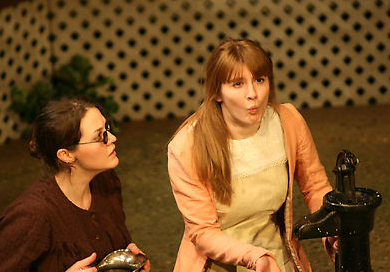This is the opinion of Reporter Dan Cook.
“Now all I have to teach you is one word – everything.”
That was what Anne Sullivan said as she was teaching Helen Keller in “The Miracle Worker.”
St. Kate’s and St. Thomas’ production of “The Miracle Worker” opened Wednesday, and an impressive performance welcomed audiences to the show.
“The Miracle Worker” is a play by William Gibson, based on the autobiography of Helen Keller. The play has been around for more than 50 years, and was the basis for the 1962 movie of the same name. The story focuses on Helen as a child, wild and untamed. The play shows us how Anne Sullivan entered her life and taught her language and discipline.
Director Teresa Lyons-Hegdahl said she was looking for a script that would help foster a partnership with the sign language department.
“[The Miracle Worker] fit the bill very nicely,” Lyons-Hegdahl said. “It also had a good proportion of men and women’s roles.”
Heather Nordby, a St. Kate’s student, played the challenging lead role of Helen Keller. Lyons-Hegdahl discussed the challenges of working with a character who is blind, deaf and mute.
“We used a variety of methods to try to assist her in experiencing that sense of isolation that Helen experiences,” Lyons-Hegdahl said. “We have blindfolded her, we have put noise-reduction earphones on her, and we have done a lot of research and reading on what this young girl would have experienced.”
Norby played the role brilliantly. Building a character throughout a play is extremely difficult when that character has no lines. But the progression of Helen’s character was clear throughout the play, and she interacted well with the characters around her.
Jayne Hess, also a St. Kate’s student, played Helen’s teacher Anne Sullivan. Jayne’s characterization was spot-on, and she was fun to watch. She was able to pull off the dramatic scenes with Helen quite well, and the connection between the two was obvious.
“There is a wonderful sense of partnership and a wonderful sense of collaboration between the two actresses,” Lyons-Hegdahl said.
The play had a very nice set that made scene changes seamless and easy to follow. But the configuration of the set did obstruct the views of audience members sitting at either end of the stage. At some points in the play, audiences basically got a “split-screen,” where two different spots on the stage would be lit up, and the action would alternate between the two locations.
This was a very interesting touch. However, it was slightly distracting to see people moving about on the unlit side of the stage when the focus was supposed to be on a different place on the set.
The play started off a little slower and less dramatically than I would have expected. But the pace picked up a bit in the next scene, and this pace was maintained through most of the play.
Unfortunately, “The Miracle Worker” is designed as a three-act play. The two intermissions seemed to halt the momentum that the play had going, and viewers had to get re-accustomed to the play and its action not once, but twice. Because this is how the play was written, there is not much a director can do to fix this, but it broke up the action a little too much.
At different points during the play, Anne Sullivan had flash backs of memories of her younger brother. The voiceover for the younger brother was powerful and effective, and it set the tone in key moments.
Several of the characters had accents during the play. The actors who used them were fairly consistent throughout the play, although some the actors tended to lose some of their diction and articulation when they added the accent. Different actors had different levels of success at mastering their accents.
Overall the performance went very well, especially for an opening-night performance. There were few slip-ups, and the actors took command of their roles.
Dan Cook can be reached at Cook9156@stthomas.edu.

